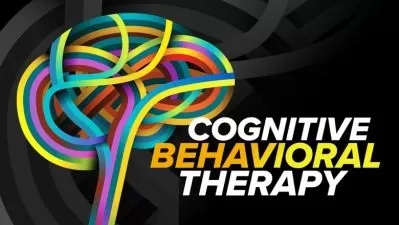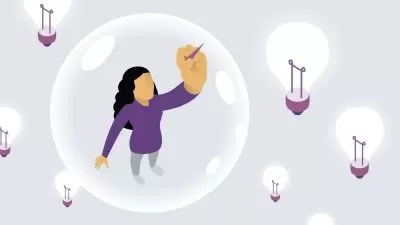Cognitive Behavioral Therapy for Daily Life
Jason M. Satterfield
12:25:48
Description
You talk to yourself all day long. We all do. Most of what we say carries no emotional weight: “Don’t forget to pick up the milk and bread.” Or, “I want to mention that book to my brother.” But sometimes, what we tell ourselves affects the very quality of our lives. We tell ourselves that we aren’t good enough, that our circumstances define us, that we can’t fix or change the things that seem to be weighing us down. This negative self-talk can follow us all day long and deeply impact our lives, whether we notice it or not.
How do we combat this negativity, especially when we seem to carry it around without really realizing the effect it can have on our daily life and its impact our mental health and happiness?
In the 24 compelling half-hour lectures of Cognitive Behavioral Therapy for Daily Life, Professor Jason Satterfield will help you build your own cognitive behavioral therapy (CBT) toolbox, giving you the skills you need to change those stories that hold you back and that keep you from experiencing your fullest life possible. Just like your physical toolbox, you’ll learn exactly which tools to gather and how and when to use each one most effectively. These tools aren’t magical quick-fixes, and they can’t accomplish everything you might want. But in using them appropriately, you will be building a life that is both more powerful and more peaceful than you had ever imagined.
Our previous course with Professor Satterfield on this subject, Cognitive Behavioral Therapy: Techniques for Retraining Your Brain, introduced the concept of CBT and demonstrated how it works and the ways it can be applied. This new addition to our exploration of CBT will help you further introduce these techniques and thought patterns into your daily life; it presents an array of new tools and many new scenarios to help you see CBT in action. These courses can be watched separately or as a pair, and both can be easily understood and applied on their own.
CBT: A Problem-Solving Approach
CBT was originally developed in the 1960s by a psychiatrist who had been using psychoanalysis to help his depressed patients—a process that could sometimes take years. But through experimental work, he discovered something he found completely surprising: His depressed patients were constantly experiencing streams of spontaneous, negative thoughts about themselves, the world, and their future. As he helped his patients evaluate these thoughts, they began to think more realistically, feel better emotionally, and function better. And the results of this emerging therapy were long-lasting.
The CBT approach helps us because it’s almost never just the situation at hand that directly affects our emotional health—it’s our thoughts about the situation. We’ve all seen this in our own lives when we’ve witnessed one divorced friend sink into a years-long downward spiral, while another divorced friend rebuilds his or her life. We’ve seen one family member with a chronic illness withdraw into the smallest possible life while another person with the same illness maintains an interest in life and emotional growth. Divorce and chronic illness both present significant difficulties, but it’s how the person addresses those challenges that can make all the difference.
While CBT cannot put the marriage back together after divorce or miraculously cure physical illness, the CBT tools you’ll learn to use in this course will help you address many of life’s challenges in a way that best nourishes your emotional health. Those challenges might include:
- Grief after the loss of a loved one;
- Coping with chronic pain;
- Marital conflicts;
- Difficulties with coworkers;
- Parenting challenges;
- End-of-life issues; and more.
Building Your Personal CBT Toolbox
As Professor Satterfield demonstrates, the best way to envision CBT is to think of an equilateral triangle with the points representing behavior, cognition, and emotions. Each of these points influences the other two, with information and effects streaming in both directions. It is that intricate relationship between our behavior, cognition, and emotions that forms the foundation of CBT’s problem-solving tools. With the appropriate tools and skills for each situation, we can move toward “Wise Mind”—the equilibrium where we can best access the strength of both our rational and emotional selves to address the problem at hand.
In this skills-based course, you will learn about both cognitive and behavioral tools, each of which will help you move toward better emotion regulation and functional improvements. Among the CBT tools you will learn how to use and benefit from in this course are:
- Self-assessment,
- Thought records,
- Activity scheduling,
- Problem-Solving Therapy,
- Exposure Therapy,
- Somatic Quieting, and
- Behavioral Activation.
And while you might not need to use every CBT tool right now, you will find some that can be applied in a wide variety of situations. Over time, as you really learn to incorporate CBT into your own life through practice, you might develop “favorite” CBT tools that seem to be the most beneficial for you with the greatest efficacy in the shortest amount of time.
Watching CBT in Action
In Cognitive Behavioral Therapy for Daily Life, you’ll have the opportunity to be the proverbial fly on the wall of the therapist’s office. As you see actors portraying clients, you see Dr. Satterfield discussing his thoughts about the clients—explaining what he learns from what they do say and do not say, their body language, their willingness to take on and accomplish homework assignments, and more. He also explains which specific CBT tool(s) he chooses for each of the six clients and why:
- Amanda, a 27-year-old single college graduate who moved back in with her parents after not being able to find a good job. Four years later, she is still there, resentful and afraid she will never have the future she imagined and worked so hard for.
- Christian, a 35-year-old single man who has been struggling with insomnia for seven years, tossing and turning for hours before becoming exhausted enough to finally sleep.
- David, a 73-year-old married father and grandfather whose colon cancer returned after earlier chemotherapy and surgery. The cancer is now inoperable, and David knows he is facing the end of his life.
- Miriam, a 63-year-old widow and mother who works in school administration and worries about her finances and health. She recently lost her own mother and is tearful, sometimes depressed, and worries all the time.
- Scott, a 50-year-old man who has become physically dependent on the high-dose opioids he has taken for years in response to back pain. Frustrated and angry, he feels betrayed by his doctors who now want him to taper off the drugs.
- Stephen, a 44-year-old single man who describes himself as neurotic and sensitive. He copes with his anxiety by being quiet and detached, but then feels left out and overlooked. He often turns his hurt feelings into anger and withdraws from others.
Since several of these clients are shown in multiple sessions over time, you’ll see first-hand how they benefit from the implementation of CBT in their lives. And as you follow these clients, you’ll be developing the CBT tools you can use to help yourself and maybe those you love. These tools and skills will not only help you address problems, but will also help you learn to create and savor positive experiences that bring greater happiness, satisfaction, and meaning to your life.
More details
User Reviews
Rating
Jason M. Satterfield
Instructor's CoursesProfessor Jason M. Satterfield is Professor of Clinical Medicine, Director of Social and Behavioral Sciences, and Director of Behavioral Medicine in the Division of General Internal Medicine at the University of California, San Francisco (UCSF). He earned his B.S. in Brain Sciences from the Massachusetts Institute of Technology and his Ph.D. in Clinical Psychology from the University of Pennsylvania. He currently directs the UCSF Behavioral Medicine Unit, which integrates mental and behavioral health services into adult primary care. Professor Satterfield’s book, A Cognitive-Behavioral Approach to the Beginning of the End of Life: Minding the Body, was recognized as a Self-Help Book of Merit by the Association for Behavioral and Cognitive Therapies. He served on the Behavioral and Social Science Subcommittee that revised the Medical College Admission Test-work that was recently featured in the New England Journal of Medicine and The New York Times. Professor Satterfield is also part of a core interdisciplinary team that is writing a medical textbook based on the biopsychosocial model. He has been nominated for multiple teaching awards at UCSF, and he is often competitively selected to teach at national conferences for a wide variety of health professionals, including physicians, nurses, social workers, and psychologists.

The Great Courses
View courses The Great Courses- language english
- Training sessions 25
- duration 12:25:48
- English subtitles has
- Release Date 2023/08/19

























